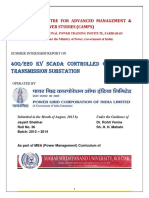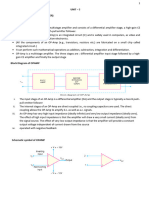Power Distribution & Utilization
Uploaded by
Anonymous 5GBBc45Power Distribution & Utilization
Uploaded by
Anonymous 5GBBc45Department of (S & T), FEST, Indus University, Karachi
Faculty of Engineering, Sciences & Technology
INDUS UNIVERSITY
POWER DISTRIBUTION & UTILIZATION
Lab Manual
For
Spring 2019
Prepared By: Engr. Ghulam Abid
Student Name: .
Student ID: .
Electrical Power Distribution & Utilization (Lab Manual)
Department of (S & T), FEST, Indus University, Karachi
TABLE OF CONTENTS
Lab# Experiments Marks Date Signature
1
To study the major equipment of the substation and make a
one-line diagram.
2
To demonstrate the operational and constructional feature of a
Distribution Transformer.
3
To demonstrate Load performances of a distribution
transformer Y connected
4
To study parts of Cables and select appropriate cable size for
given load
5
To demonstrate the Power factor improvement by connecting
Capacitors with R and L Load
6 To study operation of a switching station with two bus bars
and different voltages
7
To study bus bar coupling and bus bar transfer without
interruption of the power supply to the consumer.
8
To study different types of lamps and comparing the
illumination level.
9 a).To become familiar with the basic environment of lighting
design software CALCULUX
b).To design a general lighting scheme of an office using
CALCULUX
10
a). To measure the LUX level on the given working plane
b). To design a task & accent lighting for an office (Optional)
11
To study types of tariff and calculate the charges in
Residential/Industrial/commercial bill.
12 To study Earthing Resistance and Soil resistivity.
Electrical Power Distribution & Utilization (Lab Manual)
Department of (S & T), FEST, Indus University, Karachi
EXPERIMENT #1
Substation Equipment & One Line Diagram
OBJECTIVE
To study the major equipment’s of the substation and make a one-line diagram.
APPARATUS
A visit will be arranged to a sub-station.
THEORY
An electrical substation is a subsidiary station of an electricity generation, transmission and
distribution system where voltage is transformed from high to low levels using
transformers. Electric power may flow through several substations between generating
plant and consumer, and may be changed in voltage in several steps.
Feeders
The electrical distribution system begins with a source of electrical energy that must be
distributed to each and every electrical load. The starting point of this system, which feeds
electrical energy into it, is known as a Feeder. The electricity delivered by a feeder is
actually distributed to different loads in the system.
Distributors
A distributor is a conductor from which tapings are taken to the consumers. The current
through a distributor is not constant due to the tapings taken off at various places along its
length. While designing a distributor, voltage drop along its length is the main
consideration as the voltage variation limits are about 6% of the rated voltage at the
consumer terminals.
Switch Gears
The term switchgear, used in association with the electric power system, or grid, refers to
the combination of electrical disconnects, fuses and/or circuit breakers used to isolate
electrical equipment. Switchgear is used both to de-energize equipment to allow work to be
done and to clear faults downstream Panels are the compartments used for switchgear
arrangement.
Switching Devices
A device designed to close, open, or both, one or more electric circuits.
These include
HRC fuses
Magnetic contactor
Circuit Breaker (Molded Case Circuit Breaker)
Electrical Power Distribution & Utilization (Lab Manual)
Department of (S & T), FEST, Indus University, Karachi
Symbols for Equipment in Sub-Stations
To show the various elements of a sub-station by their graphic symbols in the connection
S. No Circuit Element Symbol
Electrical Power Distribution & Utilization (Lab Manual)
Department of (S & T), FEST, Indus University, Karachi
The large network of conductors between the power station and the consumers can be broadly
divided into two parts, transmission system and distribution system. Each part can be further
sub-divided into two—primary transmission and secondary transmission and primary
distribution and secondary distribution. Figure shows the layout of a typical a.c. power supply
scheme by a single line diagram.
Electrical Power Distribution & Utilization (Lab Manual)
Department of (S & T), FEST, Indus University, Karachi
One Line Diagram of a typical power system.
Electrical Power Distribution & Utilization (Lab Manual)
Department of (S & T), FEST, Indus University, Karachi
One Line diagram of a typical Distribution system
Electrical Power Distribution & Utilization (Lab Manual)
Department of (S & T), FEST, Indus University, Karachi
EXERCISE
Design one line diagram from the following layout of pole mounted substation. Also explain
working.
Electrical Power Distribution & Utilization (Lab Manual)
Department of (S & T), FEST, Indus University, Karachi
Explain the purpose of following Equipments
1. Fuse
2. Circuit breaker
3. Isolator
4. Current Transformer
5. Potential Transformer
Electrical Power Distribution & Utilization (Lab Manual)
Department of (S & T), FEST, Indus University, Karachi
EXPERIMENT #2
To demonstrate the operational and constructional feature of a
Distribution Transformer.
OBJECTIVE
To study the operation and constructional features of a Distribution Transformer
APPARATUS
Distribution Transformer
THEORY
Distribution transformer is used to convert electrical energy of higher voltage (usually 11-22-
33kV) to a lower voltage (220 or 430V) with frequency identical before and after the
transformation. Its main application is mainly within suburban areas, public supply authorities
and industrial customers. With given secondary voltage, distribution transformer is usually the
last in the chain of electrical energy supply to households and industrial enterprises.
Power Transformer
Electrical Power Distribution & Utilization (Lab Manual)
Department of (S & T), FEST, Indus University, Karachi
CONSTRUCTION
There are 3 main parts in the distribution transformer:
Coils/winding: where incoming alternating current (through primary winding) generates
magnetic flux, which in turn induces a voltage in the secondary coil.
Magnetic core: material allowing transfer of magnetic field generated by primary winding to
secondary winding by the principle of electromagnetic induction. A transformer’s core and
windings are called its Active Parts. This is because these two are responsible for transformer s
operation.
Tank: serving as a mechanical package to protect active parts, as a holding vessel for
transformer oil used for cooling and insulation.
Transformer Accessories
Breather
Pressure relief device
Temperature Indicator
Tap Changer etc.
PROCEDURE
Practical demonstration.
RESULT
Complete working of the distribution transformer has been understood.
EXERCISE:
Give the purposes of following parts of Distribution Transformer
1. Bushings
2. Conservator or expansion tank
3. Breather
4. Pressure relief device
5. Tap Changer (OFF Load)
Electrical Power Distribution & Utilization (Lab Manual)
Department of (S & T), FEST, Indus University, Karachi
Answer following MCQ’s
1. Transformer is a device which:________________.
a. Transfer Electrical power from one electrical circuit to another Electrical circuit
b. It’s working without changing the frequency
c. Work through on electric induction.
d. When, both circuits take effect of mutual induction
e. Can step up or step down the level of voltage.
f. Its Working without changing the Power.
g. All of the above
2. What will happen if the primary of a transformer is connected to D.C supply?
a. Transformer will operate with low efficiency
b. Transformer will operate with high efficiency
c. No effect
d. Transformer may start to smoke and burn
3. What would happen if we operate a 60 Hz Transformer on 50 Hz Source of Supply?
a. Current will decrease
b. Current will increase
c. Current will be same in both cases.
d. No Effect
4. The maximum efficiency of a distribution transformer is
a. at no load
b. at 50% full load
c. at 80% full load
d. at full load
5. In a transformer the tappings are generally provided on
a. primary side
b. secondary side
c. low voltage side
d. high voltage side
6. The leakage flux in a transformer depends upon
a. load current
b. load current and voltage
c. load current, voltage and frequency
d. load current, voltage, frequency and power factor
Electrical Power Distribution & Utilization (Lab Manual)
Department of (S & T), FEST, Indus University, Karachi
7. Power transformers are designed to have maximum efficiency at
a. nearly full load
b. 70% full load
c. 50% full load
d. no load
8. For a transformer with number of secondary windings more than the number of primary
windings, the secondary current will be
a. More than the primary current
b. Less than the primary current
c. Equal to the primary current
d. Zero
9. A Step Up transformer _____________.
a. Step Up the level of Voltage
b. Step down the level of current
c. Step up level the power
d. Step up the level of Frequency
e. 1 and 2 only
10. An Auto-transformer (which has only one winding) may be used as a ______?
a. Step-Up Transformer
b. Step-Down Transformer
c. Both Step-Up and Step-Down transformer
d. None of the above
Electrical Power Distribution & Utilization (Lab Manual)
Department of (S & T), FEST, Indus University, Karachi
EXPERIMENT #3
To Demonstrate load performance of distribution transformer
OBJECTIVES
• Measuring the effect of the load type and magnitude on the performance of the secondary
voltage.
• Determining the efficiency of the transformer.
EQUIPMENTS
• 1 IT 6000 Three-phase power supply
• 1 IT 6003 Three-phase transformer
• 1 IT 6004 Resistive load
• 1 IT 6005 Inductive load
• 1 IT 6006 Capacitive load
• 2 IT 6048 Power meter
• 1 IT 6035 Moving-iron ammeter (2.5 A)
• 1 IT 6038 Moving-iron voltmeter (125 - 250 - 500 V)
THEORY
During load operation we are referring to a load condition which falls into the range of
standard transformer loads, i.e. a current, which is considerably larger than the no-load
current, but also significantly smaller than the short-circuit current. When we speak
about the efficiency of electrical machines we mean the ratio of the active power output
to the active power consumed. Transformers in power engineering excel because of
their high efficiency, which can exceed the 98% value. But even at these excellent levels,
the losses occurring in large units are considerable and make compulsory cooling a
requirement.
Electrical Power Distribution & Utilization (Lab Manual)
Department of (S & T), FEST, Indus University, Karachi
Load Performance
Electrical Power Distribution & Utilization (Lab Manual)
Department of (S & T), FEST, Indus University, Karachi
EXPERIMENT PROCEDURE
Assemble the circuit in accordance with the foregoing topographic diagram. Set the
primary-side of the three-phase transformer in star connection 380 V (phase voltage 220
V) and the secondary-side with UN = 220 V winding tap in star connection. The resistive
load will be used as the first load. It is connected, like the inductive and capacitive
loads, in star connection. Before starting the measurements the load is set to zero.
Adjust the supply voltage in order to obtain the secondary nominal no-load phase to
neutral voltage U20 = 220 V. Beginning from the R1 value reduce the resistive three-
phase load in steps till the R6 value. For each step measure the load voltage U2 and
current I2 as well as the active power absorbed P1 at primary and P2 at load. Enter the
measured values in the following table and calculate the voltage drop ∆U = U20 - U2 and
the efficiency h = P2/P1.
Measured:
Load
U20 (Vp) U2 (Vs) ∆U (V) Is (A) Pp (W) Ps (W) ɳ (%)
220
R1
220
R2
220
R3
Calculation from measured values.
U20 Qs=Ss
Load Sp=IpVp Cos p Qp=SpSin Ss=IsVs Cos s s
(V) Sin s
R1 220
R2 220
R3 220
Now the resistive load is replaced by the inductive load. The above measurements are
repeated in the same fashion for the indicated three-phase inductive loads. Enter the
measured values in the following tables.
Electrical Power Distribution & Utilization (Lab Manual)
Department of (S & T), FEST, Indus University, Karachi
INDUCTIVE LOAD
Load U20 (Vp) U2 (Vs) ∆U(V) Is (A) Pp (W) Ps (W) ɳ (%)
L1 220
L2 220
L3 220
Calculation from measured values.
U20 Qs=Ss
Load Sp=IpVp Cos p Qp=SpSin Ss=IsVs Cos s s
(V) Sin s
L1
220
L2
220
L3
220
Electrical Power Distribution & Utilization (Lab Manual)
Department of (S & T), FEST, Indus University, Karachi
Review Questions
1. Does the transformer draw any current when its secondary is open? Explain?
2. Is copper loss affected by power factor? Why?
3. What affects are produces by change in voltage?
4. How does change in frequency affect the operation of a given transformer?
Electrical Power Distribution & Utilization (Lab Manual)
Department of (S & T), FEST, Indus University, Karachi
EXPERIMENT #4
Introduction to Power Cables and Select Appropriate Cable Size
OBJECTIVES
To study parts of Cables and select appropriate cable size for given load
THEORY
A cable is defined as an assembly of conductors and insulators used for the transfer of
power in densely populated urban areas. Cables are mostly laid under the ground in
order not to disturb the land beauty and to avoid using the land for power transmission
& distribution purposes.
PARTS OF CABLE
A cable is composed of the following parts;
Core
All cables either have a central core (conductor) or a number of cores made of strands of
Copper or Aluminum conductors having highest conductivity. Conductors are stranded
in order to reduce the skin effect.
Insulation
It is provided to insulate the conductors from each other and from the outside
periphery. The common insulating materials are Poly Vinyl Chloride (PVC) and
Polyethylene.
Metallic Sheath
Metallic Sheath protects the cable against the entry of moisture. It is made of lead, some
alloy of lead or Aluminum
Electrical Power Distribution & Utilization (Lab Manual)
Department of (S & T), FEST, Indus University, Karachi
Bedding
In order to protect the metallic sheath from injury, bedding is wound over it. It consists
of paper tape compounded with a fibrous material.
Armoring
It consists of one or two layers of galvanized steel wires or two layers of steel tape, to
avoid the mechanical injury. Armoring provides mechanical strength to the cable.
Serving
A layer of fibrous material, used to protect the armoring.
The cable selection procedures set out in this LAB SESSION will give the basic
guidelines to be followed to determine the minimum size of cable required to satisfy a
particular installation condition.
The following three main factors influence the selection of a particular cable to satisfy
the circuit requirements:
(a) Current-carrying capacity dependent upon the method of installation and the
presence of external influences, such as thermal insulation, which restrict the operating
temperature of the cable.
(b) Voltage drop dependent upon the impedance of the cable, the magnitude of the load
current and the load power factor.
(c) Short-circuit temperature limit dependent upon energy produced during the short
circuit condition.
TASK:
Determine the size of cable required & voltage drop in the cable.
What type and size of cable suits for given situation
Load = 5.8kW
Volts = 230V
Length of Circuit = 35meter
Temperature = 35°C (95°F)
For a given load, cable size may be found with the help of different tables but we
should keep in mind and follow the rules about voltage drop.
Determining the size of cable for a given load, take into account the following rules.
For a given load except the known value of current, there should be 20% extra scope of
current for additional, future or emergency needs.
voltage drop should not exceed 2.5% of Supply voltage.
Consider the change in temperature, when needed, use temperature factor (Table 3)
Load = 5.8kW = 5800W
Voltage = 230V
Current = I = P/V = 5800 / 230 = 25.2A
20% additional load current = (20/100) x 5.2A = 5A
Electrical Power Distribution & Utilization (Lab Manual)
Department of (S & T), FEST, Indus University, Karachi
Total Load Current = 25.2A + 5A = 30.2A
Now select the size of cable for load current of 30.2A (from Table 1) which is 7/1.04 (31
Amperes) it means we can use 7/1.04 cable according table 1.
Now check the selected (7/1.04) cable with temperature factor in Table 3, so the
temperature factor is 0.97 (in table 3) at 35°C (95°F) and current carrying capacity of
(7/1.04) is 31A, therefore, current carrying capacity of this cable would be;
Current rating for 35°C (95°F) = 31 x 0.97 = 30 Amp.
Since the calculated value (30 Amp) at 35°C (95°F) is less than that of current carrying
capacity of (7/1.04) cable which is 31A, therefore this size of cable (7/1.04) is also
suitable with respect to temperature.
Now find the voltage drop for per ampere meter for this (7/1.04) cable from (Table 5)
which is 7mV, But in our case, the length of cable is 35 meter. Therefore, the voltage
drop for 35 meter cable would be:
Actual Voltage drop for 35meter = mV x I x L
(7/1000) x 30×35 = 7.35V
And Allowable voltage drop = (2.5 x 230)/100 = 5.75V
Here the actual Voltage drop (7.35V) is greater than that of maximum allowable voltage
drop of 5.75V. Therefore, this is not suitable size of cable for that given load. So we will
select the next size of selected cable (7/1.04) which is 7/1.35 and find the voltage drop
again. According to Table (5) the current rating of 7/1.35 is 40Amperes and the voltage
drop in per ampere meter is 4.1 mV (See table (5)). Therefore, the actual voltage drop for
35 meter cable would be;
Actual Voltage drop for 35meter =
= mV x I x L
(4.1/1000) x 40×35 = 7.35V = 5.74V
This drop is less than that of maximum allowable voltage drop. So this is the most
appropriate and suitable cable size.
EXERCISE:
Following Loads are connected in a building:-
Sub-Circuit 1
2 lamps each o 1000W and
4 fans each of 80W
2 TV each of 120W
Sub-Circuit 2
6 Lamps each of 80W and
5 sockets each of 100W
4 lamps each of 800W
If supply voltages are 230V then calculate circuit current and Cable size for each Sub-
Circuit?
Electrical Power Distribution & Utilization (Lab Manual)
Department of (S & T), FEST, Indus University, Karachi
Fill in the blanks by picking up correct words.
1. For voltages less than 66 kV, a 3-phase cable usually consists of.............................
i. 3-core cable
ii. 3 single-core cables
iii. none of above
2. If the length of a cable is doubled, its capacitance is....................................
i. doubled
ii. halved
iii. quadrupled
3. The minimum dielectric stress in a cable is at................................
i. conductor surface
ii. lead sheath
iii. non of above
4. For operating voltages beyond 66 kV ... …………………….cables are used.
i. Belted,
ii. S.L. type
iii. oil-filled
5. Voids in the layers of impregnated paper insulation................. the breakdown
voltage of the cable.
i. increase
ii. decrease
iii. both of above
6. For voltages beyond 66 kV, 3-phase system usually employs...........................
i. 3-core cable
ii. 3 single core cables
iii. both of above
7. If the length of a cable increases, its insulation resistance ................ .
i. increase
ii. decrease
8. The most commonly used insulation in high-voltage cables is ............
i. impregnated paper
ii. PVC
iii. Rubber
Electrical Power Distribution & Utilization (Lab Manual)
Department of (S & T), FEST, Indus University, Karachi
9. A metallic sheath is provided over the insulation to protect the cable from....................
i. leakage current
ii. moisture
iii. non of these
10. Voltage drop in cable system is less than that of equivalent overhead line because of
................ of conductors in a cable.
i. closer spacing
ii. higher spacing
iii. non of these
Electrical Power Distribution & Utilization (Lab Manual)
Department of (S & T), FEST, Indus University, Karachi
EXPERIMENT #5
Power Factor Improvement
OBJECTIVES
To improve power factor of a distribution load
APPARATUS
Line module IT-6002
Line Capacitor IT-6021
Power meter
Resistive Load
Inductive load
THEORY
The ratio of the actual power consumed by equipment (P) to the power supplied to
equipment (S) is called the power factor.
𝐴𝑐𝑡𝑖𝑣𝑒 𝑃𝑜𝑤𝑒𝑟 𝑃
Power Factor = =
𝐴𝑝𝑝𝑎𝑟𝑎𝑛𝑡 𝑃𝑜𝑤𝑒𝑟 𝑆
The low power factor is mainly due to the fact that most of the power loads are
inductive and, therefore, take lagging currents. In order to improve the power factor,
some device taking leading power should be connected in parallel with the load. One of
such devices can be a capacitor. The capacitor draws a leading current and partly or
completely neutralizes the lagging reactive component of load current. This raises the
power factor of the load
Power factor correction reduces the Joule losses of the transformers and the cables
upstream of the installation point; reduction in losses, transmitted power being equal, is
greater the lower the power factor value before applying the power factor correction.
The capacitor provides the necessary leading current which results in reduce line
current flowing in the system.
Electrical Power Distribution & Utilization (Lab Manual)
Department of (S & T), FEST, Indus University, Karachi
CAUSES OF LOW POWER FACTOR
(i) Most of the a.c. motors are of induction type (1φ and 3φ induction motors) which
have low lagging power factor. These motors work at a power factor which is extremely
small on light load (0·2 to 0·3) and rises to 0·8 or 0·9 at full load.
(ii) Arc lamps, electric discharge lamps and industrial heating furnaces operate at low
lagging power factor.
(iii) The load on the power system is varying being high during morning and evening
and low at other times. During low load period, supply voltage is increased which
increases the magnetization current. This results in the decreased power factor.
EFFECT OF LOW POWER FACTOR
(i) It causes overloading of conductor, transformers and other equipment.
(ii) Reduce efficiency of alternators and prime movers
(iii) Increased copper losses in transmission line
POWER FACTOR CORRECTION
Normally, the power factor of the whole load on a large generating station is in the
region of 0.8 to 0.9. However, sometimes it is lower and in such cases it is generally
desirable to take special steps to improve the power factor. This can be achieved by the
following equipment
1. Static capacitors. 2. Synchronous condenser. 3. Phase advancers.
PROCEDURE
Connect the resistive and inductive load to the line module and switch on the power
supply and adjust supply voltage 230 phase voltage. Read the power meter reading for
voltage and power factor. Increase the resistive load and read the same reading. Now
increase the inductive load and read the reading. Now connect line capacitor near to
load and note the reading.
Electrical Power Distribution & Utilization (Lab Manual)
Department of (S & T), FEST, Indus University, Karachi
OBERVATIONS
Power Factor Correction
Initial
Load Active Reactive Apparent 3x2.5µF
Power
Combination Power Power Power New Line
Factor New P.F
Current
Review Questions.
1. What are the disadvantages of poor power factor?
2. What are the causes of poor power factor?
Electrical Power Distribution & Utilization (Lab Manual)
Department of (S & T), FEST, Indus University, Karachi
3. What is the importance of power factor improvement?
4. Unity power factor is not most economical, why?
5. What are the applications of capacitors in power system?
Electrical Power Distribution & Utilization (Lab Manual)
Department of (S & T), FEST, Indus University, Karachi
6. Draw phasor diagram and power triangle of a typical distribution load.
CONCLUSION
Electrical Power Distribution & Utilization (Lab Manual)
Department of (S & T), FEST, Indus University, Karachi
EXPERIMENT #6
Double Bus bar basic system
OBJECTIVES:
Operating a switching station with two bus bars and different voltages
EQUIPMENTS
• 1 IT 6017 Three-phase power supply
• 2 IT 6019 Power circuit breaker
• 1 IT 6003 Three-phase transformer
• 1 IT 6002 Overhead line model
• 2 IT 6035 Moving-iron ammeter (2.5 A)
• 2 IT 6037 Moving-iron voltmeter (600 V)
• 1 IT 6020/4 Double busbar with 4 disconnectors
SINGLE-POLE DIAGRAM
Electrical Power Distribution & Utilization (Lab Manual)
Department of (S & T), FEST, Indus University, Karachi
EXPERIMENT PROCEDURE
Electrical Power Distribution & Utilization (Lab Manual)
Department of (S & T), FEST, Indus University, Karachi
Assemble the circuit in accordance with the foregoing topographic diagram. Special
care must be taken to ensure that the individual phases are connected correctly in order
to avoid later short-circuits. In order to fully utilise the possibilities of the double busbar
system, the busbars should be supplied from two different voltages: the voltage at the
beginning of the overhead line model (busbar 1) and the voltage at the end of the line
model (busbar 2).
Set primary-side of the three-phase transformer in delta connection 380V and set the
secondary-side to star UN-15%.
Insert all plugs connecting the capacitances to the line model.
Initially switch on the main switch in order to supply the three-phase transformer and
the line model.
The switching sequence of the two power circuit breakers (K1, K2) and of the two
disconnectors (Q1,Q2), in order to connect the busbars, is:
1. Initially activate the disconnector
2. Then activate the power circuit breaker.
E.g. Busbar 1: Disconnector Q1 on - Power circuit breaker K1 on.
S.No V1 I1 V2 I2
1
Now if we connect the three-phase balanced ohmic load to outgoing power circuit
breaker and set the load resistance value to R4, R5: the load must be supplied
alternatively from busbar 1 or from busbar 2 as desired. Initially switch on the main
switch in order to supply the three-phase transformer and the line model.
First of all a connection is to be established between busbar 1 and the load.
Switching sequence:
1. Initially activate the disconnectors Q1 and Q3.
2. Then activate the power circuit breaker K1: the bus bar 1 is alive.
3. Now activate the power circuit breaker K3: the busbar 1 feeds the load.
4. Finally activate in sequence the disconnector Q2 and the power circuit breaker
K2: the busbar 2 is alive also.
Measure the busbar voltages
S.No V1 I1 V2 I2 I
1
2
It must result I1 = I and I2 = 0: busbar 1 feeds the load.
Now carry out a bus transfer so that the supply of the load is performed from
Busbar 2.
Electrical Power Distribution & Utilization (Lab Manual)
Department of (S & T), FEST, Indus University, Karachi
The switching sequence in order to transfer the load from the busbar 1 to busbar 2 is:
1. Initially switch off the power circuit breaker K3.
The load is isolated: this phenomenon normally do not occur in practice with regard to
network operation.
2. Then switch off the disconnector Q3.
3. Now switch on the disconnector Q4.
4. Finally switch on again the power circuit breaker K3.
Measure the voltage at both busbars:
S.No V1 I1 V2 I2 I
1
2
It must result I1 =0 and I2 = I: now busbar 2 feeds the load.
Electrical Power Distribution & Utilization (Lab Manual)
Department of (S & T), FEST, Indus University, Karachi
Review Questions
1. What are different types of busbar arrangement Schemes in Substations?
2. Factors on which material of station busbar depends?
3. What are the different substation components?
4. What Are The Classifications Of The Substations According To The Design?
Electrical Power Distribution & Utilization (Lab Manual)
Department of (S & T), FEST, Indus University, Karachi
Answer the following multiple choice questions.
1. Which material is used for indoor bus bar?
a. Copper
b. Aluminium
c. Silver
d. Both (a) and (b)
2. What is / are the types of substations suitable for voltage 66 kV and above?
a. Conventional outdoor
b. SF6 gas insulated metal enclosed substation
c. Hybrid substation
d. All of these
3. A fuse is used to perform.
a. Detection
b. Interruption
c. Both detection and interruption
d. None of above
4. For voltages beyond 66 kV, switchgear equipment is installed.
a. Indoor
b. Outdoor
c. Underground
d. All of Above
5. Bus-bars is used to operate at.
a. Constant Voltage
b. Variable voltage
c. Both of above
d. Constant current
Electrical Power Distribution & Utilization (Lab Manual)
Department of (S & T), FEST, Indus University, Karachi
EXPERIMENT #7
BUSBAR COUPLING
OBJECTIVES
• Busbar coupling and busbar transfer without interruption of the power
supply to the consumer.
• Switching sequence for disconnectors and power circuit breakers.
EQUIPMENTS
• 1 IT 6017 Three-phase power supply
• 4 IT 6019 Power circuit breaker
• 1 IT 6004 Resistive load
• 1 IT 6003 Three-phase transformer
• 1 IT 6002 Overhead line model
• 3 IT 6035 Moving-iron ammeter (2.5 A)
• 2 IT 6037 Moving-iron voltmeter (600 V)
• 1 IT 6020-2 Double busbar with 2 disconnectors
• 1 IT 6020-4 Double busbar with 4 disconnectors
SINGLE-POLE DIAGRAM
Electrical Power Distribution & Utilization (Lab Manual)
Department of (S & T), FEST, Indus University, Karachi
EXPERIMENT PROCEDURE
Electrical Power Distribution & Utilization (Lab Manual)
Department of (S & T), FEST, Indus University, Karachi
Assemble the circuit in accordance with the foregoing topographic diagram. Special
care must be taken to ensure that the individual phases are connected correctly in order
to avoid later short-circuits.
In order to fully utilise the possibilities of the double busbar system, the busbars should
be supplied from two different voltages: the voltage at the beginning of the overhead
line model (busbar 1) and the voltage at the end of the line model (busbar 2).
Set primary-side of the three-phase transformer in delta connection 380 V and set the
secondary-side to star UN-15%.
Insert all plugs connecting the capacitances to the line model. Connect the three-phase
balanced ohmic load to outgoing power circuit breaker and set the load resistance value
to R5: the load must be supplied alternatively from busbar 1 or from busbar 2 as
desired.
Initially switch on the main switch in order to supply the three-phase transformer and
the line model. First of all a connection is to be established between busbar 1 and the
load.
Switching sequence:
1. Initially activate the disconnectors Q1 and Q3.
2. Then activate the power circuit breaker K1: the bus bar 1 is alive.
3. Now activate the power circuit breaker K3: the busbar 1 feeds the load.
4. Finally activate in sequence the disconnector Q2 and the power circuit breaker
K2: the busbar 2 is alive also.
Measure the busbar voltages:
U1 = .......... (V) U2 = .................... (V)
Measure the circuit currents:
I1 = ............ (A) I2 = ...........(A) I = ...............(A)
It must result I1 = I and I2 = 0: busbar 1 feeds the load.
Now carry out a bus transfer so that the supply of the load is performed from busbar 2
without interrupting the supply to the load.
The switching sequence in order to transfer the load from the busbar 1 to busbar 2
without isolating the load is:
1. Initially switch on the coupling disconnectors Q11 and Q21.
2. Then switch on the coupling power circuit breaker K4: thus the two busbar have
the same potential.
Electrical Power Distribution & Utilization (Lab Manual)
Department of (S & T), FEST, Indus University, Karachi
3. Now switch on the outgoing disconnector Q4.
4. Then switch off the outgoing disconnector Q3
5. Finally switch off again the coupling power circuit breaker K4 and then switch off the
coupling disconnectors Q11 and Q21: thus the two busbars are again separated.
Measure the voltage at both busbars:
U1 = ............(V) U2 = ................. (V)
Measure the circuit currents:
I1 = ............. (A) I2 = .................(A) I = ..................(A)
It must result I1 = 0 and I2 = I: now busbar 2 feeds the load.
Electrical Power Distribution & Utilization (Lab Manual)
Department of (S & T), FEST, Indus University, Karachi
Answer the following questions
1. Describe the function of main and transfer busbar system with neat and clean
diagram.
2. Explain Switching Operation for Transferring a Feeder to Transfer Bus from Main
Bus without Interruption of Power
Electrical Power Distribution & Utilization (Lab Manual)
Department of (S & T), FEST, Indus University, Karachi
EXPERIMENT #8
LUMINESCENCE
OBJECTIVE
Verifying the Inverse Square Law and compare the difference in output luminescence of
incandescent, fluorescent and compact fluorescent lamps.
APPARATUS
A wooden board
Connecting wires
Fluorescent Light
Incandescent Light
LUX Meter
INVERSE SQUARE LAW
The inverse-square law, which states that “the illuminance at a point on a surface
perpendicular to the light ray is equal to the luminous intensity of the source at that
point divided by the square of the distance between the source and the point of
calculation.
𝐼
𝐸= 2
𝐷
Where:
E= Illuminance in footcandles
I = Luminous intensity in candles
D= Distance in feet between the source and the point of calculation
INCANDESCENT LIGHT BULBS
Incandescent light bulbs consist of a glass enclosure (the
envelope, or bulb) which is filled with an inert gas to reduce
evaporation of the filament. Inside the bulb is a filament of
tungsten wire, through which an electric current is passed. The
current heats the filament to an extremely high temperature
(typically 2000 K to 3300 K depending on the filament type,
shape, size, and amount of current passed through). The heated
filament emits light that approximates a continuous spectrum.
The useful part of the emitted energy is visible light, but most
energy is given off in the near-infrared wavelengths
Electrical Power Distribution & Utilization (Lab Manual)
Department of (S & T), FEST, Indus University, Karachi
Different types of Incandescent Lamps
FLOURESCENT TUBE LIGHT
A fluorescent lamp or fluorescent tube is a gas-discharge lamp that uses electricity to
excite mercury vapor. The excited mercury atoms produce short-wave ultraviolet light
that then causes a phosphor to fluoresce, producing visible light. Compared with
incandescent lamps, fluorescent lamps use less power for the same amount of light,
generally last longer, but are bulkier, more complex, and more expensive than a
comparable incandescent lamp.
Types of Fluorescent lamps
Electrical Power Distribution & Utilization (Lab Manual)
Department of (S & T), FEST, Indus University, Karachi
COMPACT FLOURESCENT LIGHTS
A compact fluorescent lamp (CFL), also known as a compact fluorescent light bulb (or
less commonly as a compact fluorescent tube [CFT]), is a type of fluorescent lamp.
Many CFLs are designed to replace an incandescent lamp and can fit in the existing
light fixtures formerly used for incandescent. Compared to general service incandescent
lamps giving the same amount of visible light, CFLs use less power and have a longer
rated life, but generally have a higher purchase price.
Different Types of CFL
PROCDUERE & CALCULATIONS
Place different lamps on the wooden board & calculate the LUX level at different point
Distance from the
S.No Types of Lamp Lux
source
1
2 Incandescent
3
1
2 Fluorescent Lamp
3
1 Compact
2 Fluorescent
3 Lamp
Electrical Power Distribution & Utilization (Lab Manual)
Department of (S & T), FEST, Indus University, Karachi
Define following terms
1. Luminous Flux
2. Luminous Intensity (I)
3. Illumination (E)
4. Candela (cd)
5. Draw the circuit diagram of a fluorescent lamp showing fluorescent tube, ballast &
starter
Electrical Power Distribution & Utilization (Lab Manual)
Department of (S & T), FEST, Indus University, Karachi
Answer the following multiple choice questions
1. Candela is the unit of which.
a. Wavelength.
b. Luminous intensity.
c. Luminous flux.
d. Frequency.
2. Solid angle is expressed in terms of.
a. radians / meter.
b. radians.
c. steredians.
d. degree.
3. What will be the number of lamps, each having 300 lumens, required to obtain an
average illuminance of 50 lux on a 4m × 3m rectangular room?
a. 2
b. 4
c. 5
d. 6
4. A 200 candle power lamp is hung 4 m above the centre of circular area of 5 m
diameter. The illumination at centre of the area is.
a. 13.5 lux.
b. 12.5 lux.
c. 17.5 lux.
d. 18.5 lux.
5. The work of ballast in a fluorescent tube is to
a. limit the flow of current.
b. provide a kick start when voltage is induced.
c. both ‘a’ and ‘b’.
d. None of these.
Electrical Power Distribution & Utilization (Lab Manual)
Department of (S & T), FEST, Indus University, Karachi
EXPERIMENT #9 (a)
INTRODUCTION TO LIGHTING DESIGN SOFTWARE “CALCULUX”
OBJECTIVE
To become familiar with the basic environment of lighting design software Calculux
THEORY
This Lab session will introduce the main feature of lighting design software and with
the environment of Calculux. Calculux Indoor is a software tool which helps lighting
designers in selecting and evaluating lighting systems for offices and industrial
applications.
What can you do with Calculux Indoor?
Perform lighting calculations (including direct, indirect, total and average
illuminance) within orthogonal rooms;
Predict financial implications including energy, investment, lamp and
maintenance costs for different luminaire arrangements;
Select luminaires from an extensive Philips database or from specially formatted
files for luminaires from other suppliers;
Specify room dimensions, luminaire types, maintenance factors, interreflection
accuracy, calculation grids and calculation types;
Compile reports displaying results in text and graphical formats;
Support Switching modes and Light regulation factors;
The logical steps used for project specification save you time and effort, while the report
facility gives you the opportunity to keep permanent records of the results.
Installing the program
In order to install Calculux correctly, please stop all other applications before starting
the installation.
To install the program:
1. Start Windows.
2. Connect the USB to your USB port [Let suppose drive (K:) of your computer].
3. Follow the path K:\Calculux
4. Run the setup in the Indoor5.0b
5. Follow the instructions on screen.
Electrical Power Distribution & Utilization (Lab Manual)
Department of (S & T), FEST, Indus University, Karachi
Installing the database
1. Here in the folder DB, there is a database of Philips Luminaries
2. Install the database from the DB folder
Environment of Calculux Indoor Software
When you start Calculux, the Calculux main window is displayed. This window always
contains the menu bar, and if selected, it may also contain a tool bar and/or status line.
When a project file is open and data has been entered, a 2D top view or 3D layout is
shown.
The menu bar contains the following menus:
1. File
2. Data
3. Calculation
4. Report
5. Finance
6. View
7. Options
8. Window
9. Help
Before Starting your First Project:
Installation of Calculux Indoor has been successful;
Vignettes have been installed;
Phillum files have been installed;
Database has been installed.
Before you start 'My First Project' first you should check the default settings of
Calculux.
Electrical Power Distribution & Utilization (Lab Manual)
Department of (S & T), FEST, Indus University, Karachi
Checking the default settings
For 'First Project' you are going to check the following default settings:
Environment (options) (default settings concerning the program environment) Report
Setup Defaults (default settings concerning the contents and layout of the report)
Calculation Presentation Defaults (default settings concerning the Calculation
Presentation)
Environment
Select Environment from the Options menu.
Select the Directories tab.
Check the directory settings of the Project files, Phillum files and Vignette files.
Select the Database tab.
Check the directory settings of the Database files.
Click OK to return to the Main View.
The Environment Options only have to be set after installing Calculux
Report Setup Defaults
Select Report Setup Defaults from the Options menu.
Select the Contents tab
In the Included box, select the chapters to be included in the report.
In the Presentation Forms box, select the presentation forms of the calculation
presentation result views.
Select Textual Table, Iso Contour, Filled Iso Contour
Select the Layout tab.
In the Project Luminaire Information box, select in which way the luminaire luminous
intensity information is to be shown
Select Show Polar Diagram
In the Installation Data box, select which elements are to be displayed in chapter
'Installation Data' of the report.
Select Show Aiming Angles
In the General box, select which additional information is to be displayed and in which
language the report is to be created.
Click OK to return to the Main View.
Electrical Power Distribution & Utilization (Lab Manual)
Department of (S & T), FEST, Indus University, Karachi
Calculation Presentation Defaults
Select Calculation Presentation Defaults from the Options menu.
Select the Presentation Forms tab.
In this tab you can select the elements to be displayed in the calculation presentation
result views.
Select Textual Table, Iso Contour, Filled Iso Contour
Select the General tab.
In the Show box, select the elements to be displayed by default in the calculation
presentation and report
Select Luminaires, Luminaire Code, Luminaire Legend, Drawings,Fill Color
Legend, Room, Connected Field, Connected Grid
In the Iso Contour Method box, select which Iso Contour Method will be used by
default for the calculation presentation.
Select Relative
Select the Scaling tab.
In the Minimum Report Scale box.
Select 10
In the Sizing box, select the default sizing of the calculation presentation result views,
select
Zoomed Relative to Grid:
Factor 1.000
By setting the above scaling, the size of the defined objects in the calculation
presentation result overviews will be based on the size of the grid and the field. The size
is determined by the 'Zoom Factor'.
Click OK to return to the Main View.
Electrical Power Distribution & Utilization (Lab Manual)
Department of (S & T), FEST, Indus University, Karachi
EXPERIMENT #9 (b)
FIRST PROJECT ON LIGHTING DESIGN SOFTWARE “CALCULUX”
OBJECTIVES
Design a general lighting scheme of an office using CALCULUX. This will be your first
task of this Lab.
First Task
The details are as under:
Room Specifications
Room dimensions
Width 3.50 m Length 5.60 m Height 2.70 m
Working Plane Height 0.80 m
Reflections
Ceiling 0.50 Walls 0.30 Floors 0.10
Position (of Left Front side of the room)
X = 0.0 Y =0.0
Required illuminance level
General lighting 300 lux on working plane
Luminaire Specifications
Luminaire type TBS600/135 C7-60
Lamp type TL5 35W
Project Maintenance Factor 0.80
Electrical Power Distribution & Utilization (Lab Manual)
Department of (S & T), FEST, Indus University, Karachi
Second Task
Let suppose there is a window in the back wall of the room, two luminaries of
the Room Block arrangement have to be moved.
Add a table in the center of the room & write text on table TABLE
OBSERVATION
Attach the Self generated Report with each task.
In each report following details should be there
1) Title Page
2) Table of Contents
3) Top project overvie
4) Summary
5) Luminaries Details
6) Calculation Results
a) Filled ISO Contour
INSTRUCTION
All the observation reports should be maintained in a separate file, do not staple the
report with the workbook.
Electrical Power Distribution & Utilization (Lab Manual)
Department of (S & T), FEST, Indus University, Karachi
EXPERIMENT #10 (a)
SECOND PROJECT ON LIGHTING DESIGN SOFTWARE “CALCULUX”
OBJECTIVE
The purpose of this lab is to measure the LUX level on the given working plane. This
will be your first task of this Lab.
First Task of Second Project:
The constructional details are as under:
Room Specifications
Room dimensions
Width 7.32 m Length 7.62 m Height 3.66 m
Working Plane Height 0.80 m
Reflections
Ceiling 0.50 Walls 0.30 Floor 0.10
Position (of Left Front side of the room)
X= 0.0 Y = 0.0
Illuminance level
To be measured
Luminaire Specifications
Luminaire type Lamp Type Color
FBS331/218 M6 2xPL-L18W 840
TBS300/236 M1 2XTL-D36W 840
Project Maintenance Factor 0.80
Luminaires Location
Red Lamps (12 in Number)
Spacing
X- Spacing = 1.2m
Y- Spacing = 1.6m
Position
X=1.20 Y=1.60 Z=3.66
Electrical Power Distribution & Utilization (Lab Manual)
Department of (S & T), FEST, Indus University, Karachi
Blue Lamps (20 in Number)
Spacing
X- Spacing = 1.5m Y- Spacing = 1.6m
Position
X=1.45 Y=2.20 Z=3.66
Second task of Second Project:
In your second task
1. Group the luminaries in three separate blocks.
2. Make rectangles.
3. Make two separate grids, one for working plane & one for Table.
4. Now calculate the results.
5. Generate & Print the report.
6. Save the project.
Electrical Power Distribution & Utilization (Lab Manual)
Department of (S & T), FEST, Indus University, Karachi
OBSERVATION
Attach the self-generated Report with each task of the Project.
In each report following details should be there
1) Title Page
2) Table of Contents
3) Top project overview
4) Summary
5) Luminaries Details
6) Calculation Results
a) Filled ISO Contour
INSTRUCTION
All the observation reports should be maintained in a separate file, do not staple with
the workbook.
Electrical Power Distribution & Utilization (Lab Manual)
Department of (S & T), FEST, Indus University, Karachi
EXPERIMENT #10 (b)
THIRD PROJECT ON LIGHTING DESIGN SOFTWARE “CALCULUX”
OBJECTIVE
Design a task and accent lighting for an office.
Room Specifications
Room dimensions
Width 3.50 m
Length 5.60 m
Height 2.70 m
Working Plane Height 0.80 m
Reflections
Ceiling 0.50
Walls 0.30
Floor 0.10
Position (of Left Front side of the room)
X 0.0
Y 0.0
Luminaries Used
TBS600/135 C7-60
MASTERLINE PLUS 20W 24D [13672]
Project Maintenance Factor 0.80
Electrical Power Distribution & Utilization (Lab Manual)
Department of (S & T), FEST, Indus University, Karachi
OBSERVATION
Attach the self-generated Report with each task of the Project.
In each report following details should be there
1) Title Page
2) Table of Contents
3) Top project overview
4) Summary
5) Luminaries Details
6) Calculation Results
a) Filled ISO Contour
INSTRUCTION
All the observation reports should be maintained in a separate file, do not staple with
the workbook.
Electrical Power Distribution & Utilization (Lab Manual)
Department of (S & T), FEST, Indus University, Karachi
EXPERIMENT #11
CALCULATING TOTAL COST IN A RESIDENTIAL, COMMERCIAL OR
INDUSTRIAL BILL
OBJECTIVE
You are given an Industrial or commercial Bill
Calculate the total energy cost of the utility bill.
Explain the terms used in the bill
Perform Exercise in the end of the Lab Session
THEORY
The rates of utility companies are based upon the following guidelines:
1. The amount of energy consumed [kWh]
2. The demand rate at which energy is consumed [kW]
3. The power factor of the load.
The amount of energy consumed is measured by Energy meter and the demand of the
system during the demand interval is measured by Demand meter.
WHAT IS THE DIFFERENCE BETWEEN DEMAND AND CONSUMPTION?
Demand is how much power you require at a single point in time, measured in
kilowatts (kW).
Consumption is how much energy you use over a period of time, measured in
kilowatt-hours (kWh).
Example: assume ten lights are turned on each with a 100-watt bulb. To
accomplish this, you must draw - or demand - 1,000 watts, or 1 kW of electricity
from the power grid. If you leave all ten lights on for two hours, you would
consume 2 kWh of electricity.
DEMAND MEASUREMENT
Demand varies by customer and month. To record demand, a special meter
tracks the flow of electricity to a facility over a period of time, usually 30-minute
intervals.
Over the course of a month, the 30-minute interval with the highest demand
recorded and reflected on a monthly bill.
Minimum Charges means a charge to recover the costs for providing customer service
to consumers even if no energy is consumed during the month.
Fixed Charges means the part of sale rate in a two-part tariff to be recovered on the
basis of Billing Demand in kilowatt on monthly basis.
Electrical Power Distribution & Utilization (Lab Manual)
Department of (S & T), FEST, Indus University, Karachi
Variable Charge means the sale rate per kilowatt-hour (kWh) as a single rate or part of
a two-part tariff applicable to the actual kWh consumed by the consumer during a
billing period.
Maximum Demand where applicable , means the maximum of the demand obtained in
any month measured over successive periods each of 30 minutes duration.
Sanctioned Load where applicable means the installed load in kilowatt as applied for
by the consumer and allowed/authorized by the Company for usage by the consumer.
Power Factor shall be to the ratio of kWh to KVAh recorded during the month or the
ratio of kWh to the square root of sum of square of kWh and kVARh.
Formulae to be used:
1. Energy Charges (Rs) = No. of Units x energy charges (Rs/kWh)
2. Fuel Adjustment Charges (Rs) = No. of Units x energy charges (Rs/kWh)
3. Fixed Charges (Rs)
If MXD>50% of connected load
then
Fix Charges (Rs) = Fix charges rates x MXD
If MXD<50% of connected load
then
Fix Charges (Rs) = Fix charges rates x 50% of connected load
4. Additional Surcharge
Additional Surcharge (Rs) = No. of Units x Additional surcharge (Rs/kWh)
5. Income Tax
Applicable on Taxable Amount
Taxable Amount = Energy Charges + Fuel Adjustment Charges + Additional Surcharge
+ Fixed Charges + Electricty Duty + Meter Rent + P.f Penalty
6. Sales Tax
Sales Tax = some percent of Taxable amount (See Tarrifs)
Electrical Power Distribution & Utilization (Lab Manual)
Department of (S & T), FEST, Indus University, Karachi
EXERCISE
Attach Bill Here
Electrical Power Distribution & Utilization (Lab Manual)
Department of (S & T), FEST, Indus University, Karachi
CALCULATIONS
Electrical Power Distribution & Utilization (Lab Manual)
Department of (S & T), FEST, Indus University, Karachi
Define the following
1. Power Factor
2. Tariff
3. Load Factor
4. Demand Factor
5. Maximum Demand
Electrical Power Distribution & Utilization (Lab Manual)
Department of (S & T), FEST, Indus University, Karachi
EXPERIMENT #12
EARTHING
OBJECTIVE
To study Earthing Resistance and Soil resistivity.
APPARATUS
Earth Resistance Tester
Hammer
Measuring Tape
THEORY
Earthing provides protection to personnel and equipment by ensuring operation of
protective control gear and isolation of the faulted circuit in the following cases.
Insulation puncture or failure
Breakdown of insulation between primary & secondary windings of a
transformer.
Lighting stroke
Ensuring low earth resistance is important in earthing process. In case where protection
against the faulted list is provided by mean of fuse or a circuit breaker, the total
Resistance of the earth path must be low enough to enable the operation of the
protective device. The earth electrode resistance depends upon the electrical resistivity
of the soil in which the electrode is installed, which in turn is determined by the
following factors:
1. Nature of soil
2. Extent of moisture
3. Presence of suitable salts dissolved in moisture
Electrical Power Distribution & Utilization (Lab Manual)
Department of (S & T), FEST, Indus University, Karachi
TYPES OF EARTH ELECTRODES
Rod & Pipe Electrodes
Plate Electrodes
Strip or Round Conductor Electrodes
PLATE ELECTRODES
Plate electrodes consist of copper, cast iron or steel plate.
The minimum thickness of plate is recommended as
For cast iron - 12mm
For GI or steel - 6.3mm
For Copper - 3.15mm
And size not less than 600mm x 600mm.
Figure.1 A typical layout of plate electrode
Electrical Power Distribution & Utilization (Lab Manual)
Department of (S & T), FEST, Indus University, Karachi
The approximate resistance to ground in a uniform soil can be expressed by
where p = resistivity of soil, considered uniform in Ωm.
A= area of each side of the plate in m2
ROD & PIPE ELECTRODES
This type of earthing is more suited for a soil possessing high resistivity and the
electrode is required to be longer & driven deeper into the soil to obtain a lower
resistance to ground.
The diameter, thickness and length of the pipe is recommended as follows:
Cast iron (CI) pipes - 100mm (internal diameter), 2.5 to 3 m (long), 13mm thick.
MS pipes - 38 to 50mm (internal diameter), 2.5 to 3 m (long), 13mm thick
Copper -13,16 or 19mm diameter, 1.22 to 2.44m long.
Figure.2 A typical arrangement of pipe electrode grounding
Electrical Power Distribution & Utilization (Lab Manual)
Department of (S & T), FEST, Indus University, Karachi
In this case, the approximate resistance to ground in a uniform soil can be expressed by:
where
R= Resistance in Ω
l = length of pipe in cm
d = internal diameter of pipe in cm
RESISTIVITY OF SOIL
Type of soil Average resistivity (Ω)
1. Wet organic soil 10
2. Moist Soil 100
3. Dry Soil 1000
4. Bed rock 10000
It has been found that the resistivity of the soil can be reduces by a chemical treatment
with the following salts.
Normal Salt (NaCl) and a mixture of salt & soft coke.
MgSO4
CuSO4
CaCl2
Na2CO3
Usually the mixture of NaNo3 + sea salt + coal is used in the ratio of 1:3:5
SOIL RESISTIVITY:
Soil resistivity is the key factor that determines what the resistance of a grounding
electrode will be, and to what depth it must be driven to obtain low ground resistance.
The resistivity of the soil varies widely throughout the world and changes seasonally.
Soil resistivity is determined largely by its content of electrolytes, which consist of
moisture, minerals and dissolved salts. A dry soil has high resistivity if it contains no
soluble salts (Figuer 1).
𝜌 = 2𝜋𝑎𝑅𝑔
For Example
After inspection, the area investigated has been narrowed down to a plot of ground
approximately 75 square feet (7 m2). Assume that you need to determine the resistivity
at a depth of 15 feet (450 cm). The distance A between the electrodes must then be
equivalent to the depth at which average resistivity is to be determined (15 ft, or 450
cm). Using the more simplified Wenner formula(𝜌 = 2𝜋𝑎𝑅𝑔 ), the electrode depth
must then be 1/20th of the electrode spacing or 8-7/8” (22.5 cm).
Electrical Power Distribution & Utilization (Lab Manual)
Department of (S & T), FEST, Indus University, Karachi
For example, if the reading is R = 15
𝜌 = Soil resistivity (ohm-cm) = 6.28 x 15 x 450 = 42,390 Ω-cm
Effect of Ground Electrode Size and Depth on Resistance
Size: Increasing the diameter of the rod does not materially reduce its resistance.
Doubling the diameter reduces resistance by less than 10%.
Depth: As a ground rod is driven deeper into the earth, its resistance is substantially
reduced. In general, doubling the rod length reduces the resistance by an additional
40%. The NEC (1987, 250-83-3) requires a minimum of 8 ft (2.4 m) to be in contact with
the soil. The most common is a 10 ft (3 m) cylindrical rod which meets the NEC code. A
minimum diameter of 5/8 inch (1.59 cm) is required for steel rods and 1/2 inch (1.27
cm) for copper or copper clad steel rods (NEC 1987, 250-83-2). Minimum practical
diameters for driving limitations for 10 ft (3 m) rods are:
1/2 inch (1.27 cm) in average soil
5/8 inch (1.59 cm) in moist soil
3/4 inch (1.91 cm) in hard soil or more than 10 ft driving depths
Exercise
Create report on methods of carrying out earthing resistance and soil resistivity.
Electrical Power Distribution & Utilization (Lab Manual)
Department of (S & T), FEST, Indus University, Karachi
Answer the following Mcq’s
1. Earth wire or ground wire is made of:
a) copper
b) aluminium
c) iron
d) galvanized steel
2. Average resistance of human body is:
a) 500 ohms
b) 1000 ohms
c) 1500 ohms
d) 2000 ohms
3. Ground resistance should be designed such that:
a) grounding resistance should be as low as possible
b) grounding resistance should be as high as possible
c) grounding resistance should be always zero
d) none of the above
4. Moisture content in the soil __________the earth soil resistance:
a) increase
b) decrease
c) does not affect
d) none of the above
5. Factors on which soil resistance depends:
a) depth of the electrode
b) moisture
c) Nacl
d) all the above
6. When earth fault occurs:
a) voltage potential at the earth mat increases due to grounding
b) voltage potential at the earth mat decreases due to grounding
c) voltage potential at the earth mat remains zero irrespective of fault
d) none of the above
Electrical Power Distribution & Utilization (Lab Manual)
Department of (S & T), FEST, Indus University, Karachi
7. The objective of earthing or grounding is:
a) to provide as low resistance possible to the ground
b) to provide as high resistance possible to the ground
c) to provide flow of positive, negative and zero sequence currents
d) none of the above
8. The size of the earth or ground wire is based on the:
a) maximum fault current carrying through the ground wire
b) rated current carrying capacity of the service line
c) depends on the soil resistance
d) both (a) and (c)
9. For an EHV equipment for maintenance first it should be isolated and connected to
ground because:
a) to provide low impedance
b) to discharge the charging capacitance to ground
c) protection for operating personnel
d) both (b) and (c)
10. Generally grounding is provided for:
a) only for the safety of the equipment
b) only for the safety of the operating personnel
c) both (a) and (b)
d) none of the above
Electrical Power Distribution & Utilization (Lab Manual)
You might also like
- Summer Training Report On Unnao Sub Station100% (11)Summer Training Report On Unnao Sub Station59 pages
- Exp 5 - Symmetrical and Unsymmetrical FaultNo ratings yetExp 5 - Symmetrical and Unsymmetrical Fault7 pages
- Power Factor Meters - Electrodynamometer Type Power Factor Meter0% (1)Power Factor Meters - Electrodynamometer Type Power Factor Meter4 pages
- Power Electronics Lab Manual of 4th Sem EEE0% (1)Power Electronics Lab Manual of 4th Sem EEE32 pages
- RGPV Syllabus Btech Ee 5 Sem All SubjectsNo ratings yetRGPV Syllabus Btech Ee 5 Sem All Subjects17 pages
- A Report On The "3-Phase Line Fault Detector" Ee344 Minor Project - INo ratings yetA Report On The "3-Phase Line Fault Detector" Ee344 Minor Project - I34 pages
- Submitted To: 220 KV Sub-Station CSPTCL Bhilai-3No ratings yetSubmitted To: 220 KV Sub-Station CSPTCL Bhilai-354 pages
- Submited by:-VII Semester, IV Year Electrical Engineering Submitted To0% (1)Submited by:-VII Semester, IV Year Electrical Engineering Submitted To23 pages
- Basic Electrical Lecture Notes: Faris Elecrical Engg Department Al-Ameen Engg College, Shoranur100% (2)Basic Electrical Lecture Notes: Faris Elecrical Engg Department Al-Ameen Engg College, Shoranur16 pages
- 300+ TOP ELECTRICAL ENGINEERING Interview Questions & Answers PDF100% (1)300+ TOP ELECTRICAL ENGINEERING Interview Questions & Answers PDF88 pages
- Transmission Line Network in Himachal PradeshNo ratings yetTransmission Line Network in Himachal Pradesh13 pages
- No Load Test & Blocked Rotor Test of 3 Phase Induction Motor100% (1)No Load Test & Blocked Rotor Test of 3 Phase Induction Motor12 pages
- (Single+Three) Phase Induction Motors Interview Questions SetNo ratings yet(Single+Three) Phase Induction Motors Interview Questions Set18 pages
- 195 - EE8402, EE6402 Transmission and Distribution - Question Bank 2No ratings yet195 - EE8402, EE6402 Transmission and Distribution - Question Bank 211 pages
- Single Phasing of Three Phase Induction MotorNo ratings yetSingle Phasing of Three Phase Induction Motor33 pages
- Expt 3 - EEM - Dielectric Strength of Liquid Insulating MaterialNo ratings yetExpt 3 - EEM - Dielectric Strength of Liquid Insulating Material6 pages
- Power System Reactance Diagram Questions PDFNo ratings yetPower System Reactance Diagram Questions PDF22 pages
- PDF Pdfsecretcomcourse in Electrical Power J B Gupta PdfsdocumentscompdfNo ratings yetPDF Pdfsecretcomcourse in Electrical Power J B Gupta Pdfsdocumentscompdf2 pages
- Gate Study Material For Electrical EnginneringNo ratings yetGate Study Material For Electrical Enginnering2 pages
- Power Generation Transmission Lab ManualNo ratings yetPower Generation Transmission Lab Manual69 pages
- Load Flow Analysis of Radial Distribution NetworkNo ratings yetLoad Flow Analysis of Radial Distribution Network47 pages
- Aim: To Prepare The Connection of Sodium Vapour and Metal Halide Lamps and Measure Their Efficacies. ObjectiveNo ratings yetAim: To Prepare The Connection of Sodium Vapour and Metal Halide Lamps and Measure Their Efficacies. Objective8 pages
- Busbar Protection & Frame Leakage Protection Working Principle100% (1)Busbar Protection & Frame Leakage Protection Working Principle3 pages
- Lec - 02 - Transmission & Distribution of Electrical Power (A Technical Overview) PDFNo ratings yetLec - 02 - Transmission & Distribution of Electrical Power (A Technical Overview) PDF18 pages
- Electrical Measurements & Instrumentation NotesNo ratings yetElectrical Measurements & Instrumentation Notes86 pages
- Electrical Machines: Lecture Notes for Electrical Machines CourseFrom EverandElectrical Machines: Lecture Notes for Electrical Machines CourseNo ratings yet
- Modelling For Switching Impulse Breakdown of LiveNo ratings yetModelling For Switching Impulse Breakdown of Live8 pages
- Review of Impedance Source Power Converter For Electrical ApplicationsNo ratings yetReview of Impedance Source Power Converter For Electrical Applications25 pages
- HMI-Detachable Active Array Head, A Proposed Solution-Final - 1No ratings yetHMI-Detachable Active Array Head, A Proposed Solution-Final - 19 pages
- AE Ready Reckoner 2017 Ver.2 (PDF Booklet)No ratings yetAE Ready Reckoner 2017 Ver.2 (PDF Booklet)23 pages
- Manie - COMINT Trends in Post ProcessingNo ratings yetManie - COMINT Trends in Post Processing16 pages
- (READ) A Modified Permanent Magnet-Assisted Synchronous Reluctance Motor Design For Torque Characteristics ImprovementNo ratings yet(READ) A Modified Permanent Magnet-Assisted Synchronous Reluctance Motor Design For Torque Characteristics Improvement10 pages
- Center Differential Lock (1999-2000) PDFNo ratings yetCenter Differential Lock (1999-2000) PDF9 pages
- A01ES-DSP3+54B-D+FM2+YL5+PEA01 - APEM A01ES Series Emergency Stop Push Button, 1NC, Surface Mount, IP65 - RSNo ratings yetA01ES-DSP3+54B-D+FM2+YL5+PEA01 - APEM A01ES Series Emergency Stop Push Button, 1NC, Surface Mount, IP65 - RS3 pages
- Calculate Size of Capacitor Bank - Annual Saving & Payback Period - Electrical Notes & ArticlesNo ratings yetCalculate Size of Capacitor Bank - Annual Saving & Payback Period - Electrical Notes & Articles4 pages
- Sybex CCNA Study Guide 640-802 (0092-0101)No ratings yetSybex CCNA Study Guide 640-802 (0092-0101)10 pages
- Advanced 8086 Microprocessor Trainer: Learning MaterialNo ratings yetAdvanced 8086 Microprocessor Trainer: Learning Material80 pages
- Nano-Va-Mang-Mong - Actuator-2 - (Cuuduongthancong - Com)No ratings yetNano-Va-Mang-Mong - Actuator-2 - (Cuuduongthancong - Com)18 pages
- Data Acquisition: Reference Book Jovitha Jerome, "Virtual Instrumentation and LABVIEW", PHI LearningNo ratings yetData Acquisition: Reference Book Jovitha Jerome, "Virtual Instrumentation and LABVIEW", PHI Learning40 pages
- Power Factor Meters - Electrodynamometer Type Power Factor MeterPower Factor Meters - Electrodynamometer Type Power Factor Meter
- A Report On The "3-Phase Line Fault Detector" Ee344 Minor Project - IA Report On The "3-Phase Line Fault Detector" Ee344 Minor Project - I
- Submited by:-VII Semester, IV Year Electrical Engineering Submitted ToSubmited by:-VII Semester, IV Year Electrical Engineering Submitted To
- Basic Electrical Lecture Notes: Faris Elecrical Engg Department Al-Ameen Engg College, ShoranurBasic Electrical Lecture Notes: Faris Elecrical Engg Department Al-Ameen Engg College, Shoranur
- 300+ TOP ELECTRICAL ENGINEERING Interview Questions & Answers PDF300+ TOP ELECTRICAL ENGINEERING Interview Questions & Answers PDF
- No Load Test & Blocked Rotor Test of 3 Phase Induction MotorNo Load Test & Blocked Rotor Test of 3 Phase Induction Motor
- (Single+Three) Phase Induction Motors Interview Questions Set(Single+Three) Phase Induction Motors Interview Questions Set
- 195 - EE8402, EE6402 Transmission and Distribution - Question Bank 2195 - EE8402, EE6402 Transmission and Distribution - Question Bank 2
- Expt 3 - EEM - Dielectric Strength of Liquid Insulating MaterialExpt 3 - EEM - Dielectric Strength of Liquid Insulating Material
- PDF Pdfsecretcomcourse in Electrical Power J B Gupta PdfsdocumentscompdfPDF Pdfsecretcomcourse in Electrical Power J B Gupta Pdfsdocumentscompdf
- Aim: To Prepare The Connection of Sodium Vapour and Metal Halide Lamps and Measure Their Efficacies. ObjectiveAim: To Prepare The Connection of Sodium Vapour and Metal Halide Lamps and Measure Their Efficacies. Objective
- Busbar Protection & Frame Leakage Protection Working PrincipleBusbar Protection & Frame Leakage Protection Working Principle
- Lec - 02 - Transmission & Distribution of Electrical Power (A Technical Overview) PDFLec - 02 - Transmission & Distribution of Electrical Power (A Technical Overview) PDF
- Electrical Machines: Lecture Notes for Electrical Machines CourseFrom EverandElectrical Machines: Lecture Notes for Electrical Machines Course
- Power System Wide-area Stability Analysis and ControlFrom EverandPower System Wide-area Stability Analysis and Control
- Review of Impedance Source Power Converter For Electrical ApplicationsReview of Impedance Source Power Converter For Electrical Applications
- HMI-Detachable Active Array Head, A Proposed Solution-Final - 1HMI-Detachable Active Array Head, A Proposed Solution-Final - 1
- (READ) A Modified Permanent Magnet-Assisted Synchronous Reluctance Motor Design For Torque Characteristics Improvement(READ) A Modified Permanent Magnet-Assisted Synchronous Reluctance Motor Design For Torque Characteristics Improvement
- A01ES-DSP3+54B-D+FM2+YL5+PEA01 - APEM A01ES Series Emergency Stop Push Button, 1NC, Surface Mount, IP65 - RSA01ES-DSP3+54B-D+FM2+YL5+PEA01 - APEM A01ES Series Emergency Stop Push Button, 1NC, Surface Mount, IP65 - RS
- Calculate Size of Capacitor Bank - Annual Saving & Payback Period - Electrical Notes & ArticlesCalculate Size of Capacitor Bank - Annual Saving & Payback Period - Electrical Notes & Articles
- Advanced 8086 Microprocessor Trainer: Learning MaterialAdvanced 8086 Microprocessor Trainer: Learning Material
- Nano-Va-Mang-Mong - Actuator-2 - (Cuuduongthancong - Com)Nano-Va-Mang-Mong - Actuator-2 - (Cuuduongthancong - Com)
- Data Acquisition: Reference Book Jovitha Jerome, "Virtual Instrumentation and LABVIEW", PHI LearningData Acquisition: Reference Book Jovitha Jerome, "Virtual Instrumentation and LABVIEW", PHI Learning

























































































